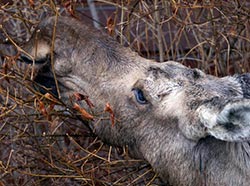Kincaid Park
Wildlife Viewing

Kincaid Park, located in west Anchorage, is a blend of 1,400 acres of wooded lands, scenic mountain and water views, and opportunities for wildlife viewing. Besides being a world-class cross-country ski area, Kincaid Park is home to many of Anchorage's resident urban moose. In fact, it can be one of the best places to see moose in Anchorage.
Choose anyone of the many trailheads beginning from the outdoor center or one of the smaller pullouts along the main road and explore miles of intersecting routes. Any time of the year you may find moose among the thick foliage that borders the road. In the spring, it is not uncommon to see a cow moose with one, two, or even three calves. Newborn calves' hair is a soft red brown, which fades to a lighter rust color. Scan the vertical and lighter landscape of trees for the darker and rounded shapes of moose.
Spring is a sensitive time for cows and calves. Learn to recognize changes in a moose's behavior and never disturb baby animals. Early morning or late evening afford the best opportunities to see moose as they often bed down during the warmer hours.
Snowshoe hares can also be seen in Kincaid Park. Tracks are easy to find in the winter. If you study the shapes and styles of different animal tracks, you may learn to recognize the tracks of red squirrels, ermine, and even lynx. People often call snowshoe hares "rabbits." Hares, however, are born with fur and their eyes wide-open, whereas rabbits are born blind and hairless. The wild hare is also able to leave the nest and hop around soon after birth. Baby rabbits are more helpless, not opening their eyes for a week or so after their birth.
Black bears occasionally den in the park and you may see them in summer and fall. While black bears are the smallest of the North American bears, the average male adult bear can weigh up to 250 pounds. If you see one, don't run, and never let them obtain human food!
Bald eagles often nest in the park, and you may see one or more from the bluffs overlooking Turnagain Arm. During spring migration, you'll also find thousands of birds, including snow geese and sandhill cranes on the mudflats below the park. Forest and woodland birds such as olive-sided flycatchers, warblers, waxwings and woodpeckers may also be seen here.
Viewing and Safety Tips
Moose can be found in most of Alaska. They prefer habitats such as hardwood forests, tall-shrub thickets, muskegs, freshwater riparian areas and coastal wetlands. Watch for newborn calves at the end of May. In late September and October, aduIt moose are in rut. Bulls with full racks often spar this time of year.
Also look here for snowshoe hares in tall shrub thickets and forest settings, including black spruce bogs. In early spring (April) hares begin to breed. Hares are generally easiest to spot in winter when tracks are easy to identify.
Accessible Facilities
The main parking lot has accessible bathrooms. A short paved trail behind the picnic shelter leads to an overlook with views of Mt. McKinley, Mt. Susitna and Cook Inlet.
Directions
Kincaid Park is located at the end of Raspberry Road toward the ocean. Take Minnesota Drive to the Raspberry Exit and head west. The main parking lot is at the very end of the road near the recreation center. Before the outdoor center and through the main gate, several pullout areas offer opportunities for day walks and wildlife viewing.
